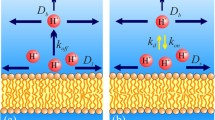Abstract
The driving force in energy-transducing membranes is now recognized to be linked to a flux of protons between membrane-bound donors and acceptors. The question of whether the proton pathway is delocalized within the two bulk aqueous phases on each side of the membrane (delocalized chemiosmotic theory1), or is localized at its surface (semi-localized hypothesis2) still remains open to discussion3,4. Using an original fluorescence monolayer technique, we have recently been able to provide direct experimental evidence that a phospholipid–water interface can act as an efficient proton conductor5,6. This observation strongly supports the semi-localized hypothesis2. In the present study, comparisons between surface potential and fluorescence measurements in monolayers provide additional evidence of a facilitated proton conduction along phospholipid–water interfaces. They suggest the existence of an induced steep surface pH gradient from a more acidic surface towards the bulk. They also show that lateral proton transfer along the surface of a biological membrane would alter the surface potential of that membrane.
Similar content being viewed by others
References
Boyer, P. D., Chance, B., Ernster, L., Mitchell, P., Racker, E. & Slater, E. A. Rev. Biochem. 46, 955–1026 (1977).
Kell, D. B. Biochim. biophys. Acta 549, 55–99 (1979).
Ferguson, S. J. Biochim. biophys. Acta 811, 47–95 (1985).
Haraux, F. Physiol. vég. 23, 397–410 (1985).
Teissié, J., Prats, M., Soucaille, P. & Tocanne, J. F. Proc. natn. Acad. Sci. U.S.A 82, 3217–3221 (1985).
Prats, M., Tocanne, J. F. & Teissié, J. Eur. J. Biochem. 149, 663–668 (1985).
Lakhdar-Ghazal, F., Tichadou, J. L. & Tocanne, J. F. Eur. J. Biochem. 134, 531–537 (1983).
Tocanne, J. F., Verheij, H. M., op den Kemp, J . A. F. & van Deenen, L. L. M. Chem. Phys. Lipids 13, 389–403 (1974).
Wojtczak, L. & Nalecz, M. J. Eur. J. Biochem. 94, 99–107 (1979).
Haines, T. H. Proc. natn. Acad. Sci. U.S.A 80, 160–164 (1983).
Sacré, M. M., El Mashak, E. M. & Tocanne, J. F. Chem. Phys. Lipids 20, 305–318 (1977).
Author information
Authors and Affiliations
Rights and permissions
About this article
Cite this article
Prats, M., Teissié, J. & Tocanne, JF. Lateral proton conduction at lipid–water interfaces and its implications for the chemiosmotic-coupling hypothesis. Nature 322, 756–758 (1986). https://doi.org/10.1038/322756a0
Received:
Accepted:
Issue Date:
DOI: https://doi.org/10.1038/322756a0
- Springer Nature Limited
This article is cited by
-
Long range physical cell-to-cell signalling via mitochondria inside membrane nanotubes: a hypothesis
Theoretical Biology and Medical Modelling (2016)
-
Membrane-induced changes in the holomyoglobin tertiary structure: interplay with function
European Biophysics Journal (2014)
-
Ecophysiology of photosynthesis in macroalgae
Photosynthesis Research (2012)
-
Microinjection in combination with microfluorimetry to study proton diffusion along phospholipid membranes
European Biophysics Journal (2008)
-
Biophysical effects of electric fields on membrane water interfaces: a mini review
European Biophysics Journal (2007)





